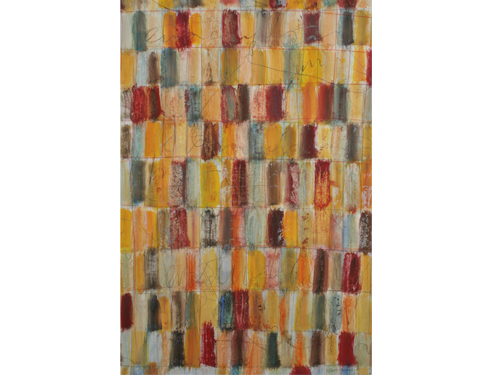It’s difficult to leave painter Khaled Hafez’s latest exhibition without a sense of intrigue. Entitled "First Temple of Flight," Hafez’s art is a mish-mash of war, mythology, escapism and feminine supremacy in feline form.
Yet it’s not abstract ambiguity that ties the whole show together, but rather the simple iconographies that relate to an accessible and exciting visual narrative.
Central to the collection is the ancient Egyptian goddess of war, Sekhmet, who takes the form of a lioness. “I use Sekhmet as a ferocious female element to represent female supremacy,” says Hafez. "It’s a visual jab in the face of the sexist conservatives prevailing in mainstream thought in the Middle East."
In his paintings, size matters: it’s another element borrowed from ancient Egypt, where larger-than-life depictions are reserved for gods or goddesses, while those lower on the social hierarchy are portrayed in smaller scale. Hence, Hafez’s employment of smaller male figures around Sekhmet and other representations of Isis–the goddess of fertility and magic–works to enhance his celebration of the feminine.
One of the more spectacular paintings on display is a 5×2 meter canvas that brings together all the collection’s themes. A female model wearing a cat mask squats comfortably on high heels, while small male figures run up to, then away from her over silhouettes of aircraft and military personnel and images of Sekhemt and Hat’hur (the latter being the Egyptian cow goddess of love and maternity, another manifestation of Isis).
A number of motifs come together here, with the notion of the exodus–conveyed through the fleeing men–being central to many of Hafez’s paintings.
“The figures fleeing from the supreme entity represent the social and political situation in the Egypt I grew up in,” he says, noting that they might represent physical escape in the form of “brain-drain” to the West, religious escape by banking on a better deal in the afterlife, or an escape to power and elitism. “In all cases," he says, "they represent escape, or flight."
The military elements, meanwhile, which also pervade his other paintings, were extracted from media sources, reworked on Photoshop, printed, then hand-painted and collaged onto the canvas in a hieroglyphic-like assemblage.
“The objective of this process is to transcend the simple reactions to visual aesthetics that painting has always offered,” he says, “and to drive the viewer to link the iconography with day-to-day, media-propagated imagery.”
Some of Hafez’s previous works are also on display, providing interesting depictions of ancient and contemporary mythology. The ancient Egyptian sky goddess Nut is omnipresent in these paintings, and Hafez uses–and distorts–top models from advertising material to simulate the goddess, whose body arches across the breadth of the sky.
“I try to probe the notion of sacred gods and goddesses with ephemeral or consumable advertising idols,” the artist explains.
One particularly captivating painting depicts Nut above a prone figure of comic-book crime-fighter Batman, as a woman with the head of a lioness–Sekhmet–looks on. "I link imagery of ancient iconography with déjà-vu contemporary elements, hence the use of Anubis, god of the underworld, and Batman, Bastet and Cat-woman," Hafez says.
Some of the paintings are for sale. The asking price for Sekhmet and Batman, for example, is a cool US$10,000.
Hafez was born in Cairo in 1963. From 1981 to 1990, he attended evening classes at Cairo University’s faculty of fine arts while studying medicine. Since then, his exhibitions have been shown in New York, Singapore and much of Europe.
Hafez’s current show can be seen at Al Masar Gallery, the artist’s agent in Egypt and the Middle East. It will continue until 18 April.


